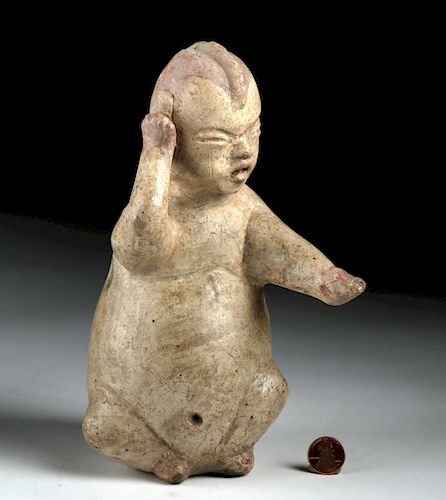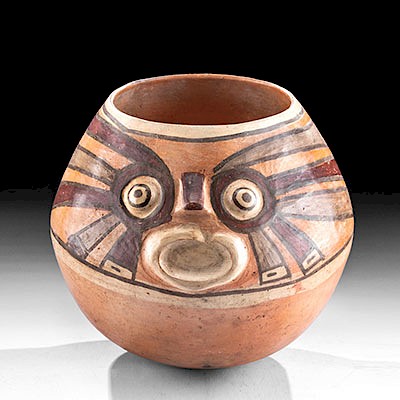Olmec Pottery Baby Figure w/ Dance-like Pose
Lot 90
About Seller
Artemis Fine Arts
686 S Taylor Ave, Ste 106
Louisville, CO 80027
United States
Selling antiquities, ancient and ethnographic art online since 1993, Artemis Gallery specializes in Classical Antiquities (Egyptian, Greek, Roman, Near Eastern), Asian, Pre-Columbian, African / Tribal / Oceanographic art. Our extensive inventory includes pottery, stone, metal, wood, glass and textil...Read more
Estimate:
$5,000 - $7,000
Absentee vs Live bid
Two ways to bid:
- Leave a max absentee bid and the platform will bid on your behalf up to your maximum bid during the live auction.
- Bid live during the auction and your bids will be submitted real-time to the auctioneer.
Bid Increments
| Price | Bid Increment |
|---|---|
| $0 | $25 |
| $300 | $50 |
| $1,000 | $100 |
| $2,000 | $250 |
| $5,000 | $500 |
| $10,000 | $1,000 |
| $20,000 | $2,500 |
| $50,000 | $5,000 |
| $100,000 | $10,000 |
| $200,000 | $20,000 |
About Auction
By Artemis Fine Arts
Dec 5, 2019
Set Reminder
2019-12-05 10:00:00
2019-12-05 10:00:00
America/New_York
Bidsquare
Bidsquare : Ancient / Ethnographic - Holiday Edition
https://www.bidsquare.com/auctions/artemis-gallery/ancient-ethnographic---holiday-edition-4710
What to give this holiday season? Ancient & Ethnographic Art of course! Our special Holiday auction features hundreds of unique finds from all over the world. Artemis Fine Arts info@artemisfinearts.com
What to give this holiday season? Ancient & Ethnographic Art of course! Our special Holiday auction features hundreds of unique finds from all over the world. Artemis Fine Arts info@artemisfinearts.com
- Lot Description
Pre-Columbian, south-central Mexico and Guatemala, Olmec culture, ca. 1000 to 200 BCE. A hollow terracotta seated Olmec Baby figure, presented in a seated, squatting position with legs tucked beneath and arms posed as if dancing what we call today - "the sprinkler" . The characteristic babyface visage presents jowly cheeks, thickly-lidded slanted almond-shaped eyes, an open mouth with slightly downturned were-jaguar lips, and a magnificent lobed coiffure comprised of a central raised ridged/braided section and two raised ovoid sections above the ears. The head itself is somewhat elongated; scholars have proposed that misshapen heads are indicative of the artificial cranial deformation practiced by the Olmec peoples. His paunchy body presents a pronounced belly button. Nice remains of a cream- and red-hued slip further adorn the piece. Size: 8.375" H (21.3 cm)
The Olmec are famous for their human depictions; as the first major civilization in this fertile area, their artwork inspired the civilizations that came after them to the point that we think some of them even revered Olmec artwork and kept it as heirlooms. Figures of this style are known as "Olmec babies", with plump bodies and chubby, pouty facial features. Infants are a recurring theme from Olmec art, and this one would likely have once been fully white-slipped to match other known examples. The shape of their heads - like this one - have been attributed to deliberate skull shaping.
Provenance: ex-private Howard Rose Gallery, New York, Albert J. & Monique Grant collection, New York, New York, USA, acquired 1950s-1960s
All items legal to buy/sell under U.S. Statute covering cultural patrimony Code 2600, CHAPTER 14, and are guaranteed to be as described or your money back.
A Certificate of Authenticity will accompany all winning bids.
We ship worldwide and handle all shipping in-house for your convenience.
#144372Repaired from about a dozen pieces with restoration over the break lines. Abrasion/loss to left hand, edges of coiffure, and other high-pointed areas. Nice remains of cream and red-hued slip. Mineral deposits grace the surface as well.Condition
- Shipping Info
-
All shipping is handled in-house for your convenience. Your invoice from Artemis Gallery will include shipping calculation instructions. If in doubt, please inquire BEFORE bidding for estimated shipping costs for individual items.
-
- Buyer's Premium



 EUR
EUR CAD
CAD AUD
AUD GBP
GBP MXN
MXN HKD
HKD CNY
CNY MYR
MYR SEK
SEK SGD
SGD CHF
CHF THB
THB














